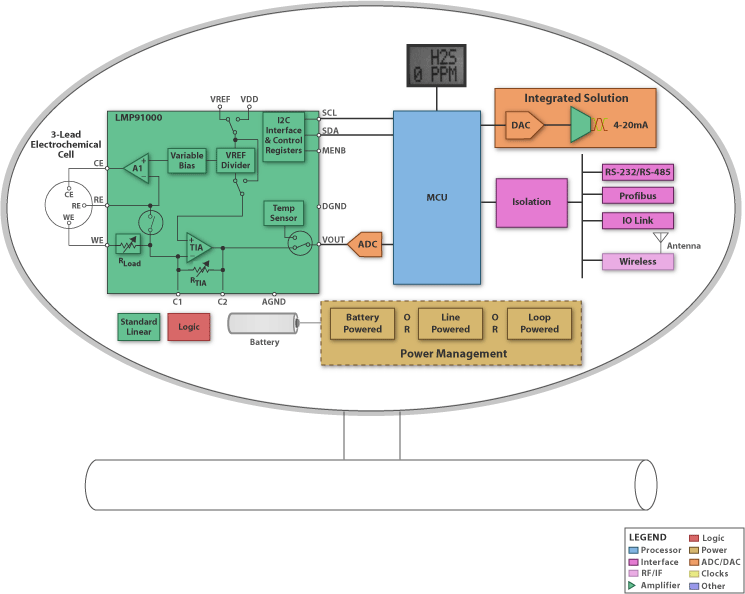
Chemical/Gas Sensor solutions are widely used as a sense mechanism for gas and chemical sensing. Common applications include carbon monoxide detectors, chemical species identification, Amperometric sensors etc. Electrochemical sensors can be considered simply as transducers that convert the physical characteristic of gas/chemical concentration to an electrical signal which can be processed by instrumentation.
Signal Conditioning:
The programmable Analog Front End (AFE) is perfect for use in micro-power electrochemical sensing applications. It provides a complete signal path solution between a sensor and a microcontroller that generates an output voltage proportional to the cell current. The programmability enables it to support multiple electrochemical sensors such as 3-lead toxic gas sensors and 2-lead galvanic cell sensors with a single design as opposed to the multiple discrete solutions. The AFE supports gas sensitivities over a range of 0.5 nA/ppm to 9500 nA/ppm. It also allows for an easy conversion of current ranges from 5µA to 750µA full scale. The adjustable cell bias and Trans-impedance amplifier (TIA) gain are programmable through the I2C interface. The I2C interface can also be used for sensor diagnostics. An integrated temperature sensor can be read by the user through the VOUT pin and used to provide additional signal correction in the µC or monitored to verify temperature conditions at the sensor. The AFE is optimized for micro-power applications and operates over a voltage range of 2.7V to 5.25V. The total current consumption can be less than 10μA. Further power savings are possible by switching off the TIA amplifier and shorting the reference electrode to the working electrode with an internal switch.
Signal Acquisition and Processing:
TI's high resolution differential ADCs have low power consumption, wide dynamic range and low noise. This can be used to digitize the conditioned analog bridge output for high resolution, precision measurements. Alternately, one could use TI's MSP430 microcontrollers with integrated ADCs and DACs. Further post processing algorithms can be run on this MCU.
Interface and Communication:
Traditional analog (4 – 20mA) interface remains the popular choice for industrial control and sensor applications. The other popular protocols include HART, Profibus and IO-Link. TI’s IO-Link interface products have integrated regulators and diagnostic outputs. In addition, wireless options based on IEEE 802.15.4 protocols are becoming more prevalent. TI is committed to provide solutions for both traditional and emerging industrial interfaces.
Microcontroller:
The Hercules™ Safety MCUs offer an ARM Cortex-R4F based solution and are certified suitable for use in systems that need to achieve IEC61508 SIL-3 safety levels. These MCUs also offer integrated floating point, 12 bit ADCs, motor-control-specific PWMs and encoder inputs via its flexible HET Timer co-processor. Hercules Safety MCUs can also be used to implement scalar and vector-control techniques and support a range of performance requirements.
Power Management:
The Field Transmitter can be powered in one of three ways. Line powered transmitters are commonly powered by voltage rails of 12V, or 24V. Loop powered transmitters are powered by the 4-20 mA loop. Such transmitters require extremely low power architectures as the entire solutions has to be powered off the loop. TI provides high efficiency Step Down converters with low quiescent current and low output ripple appropriate for Line and Loop powered transmitters. Battery powered transmitters powered can be designed using TI's low power Buck and Buck-Boost converters. The DC/DC buck converters offer over 95% efficiency over a wide battery voltage range, even with input voltage down to 1.8 volts extending battery life. Special Buck-Boost converters generate a stable required output voltage and supply constant current for over- and under-input voltage conditions and support various battery configurations.
Download Full Block Diagram Below
Advertisement

Learn more about Texas Instruments





